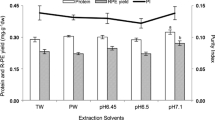Abstract
An efficient and environmentally sustainable extraction method is proposed for the enrichment of a high-value pigment, astaxanthin, from a low-value raw material, shrimp waste. Ethanol at elevated temperature and pressure was used as a “green” extraction solvent. An experimental design approach based on central composite design was used to investigate the dependence of pressurized liquid extraction (PLE) operating variables (pressure, temperature, extraction time) on the recovered astaxanthin concentration from shrimp waste. The results show that at a 95% confidence level, the most significant PLE operating variables were extraction temperature and time. Extraction pressure had only a minor effect on the astaxanthin recovery in the studied experimental conditions. The maximum astaxanthin recovery obtainable by PLE was calculated from the chemometrics results and then appraised by experiments. Our results show astaxanthin yields of around 24 mg kg−1 shrimp waste. The reproducibility of the developed PLE method is good, showing a relative standard deviation of 3.5% (n = 6) for astaxanthin.


Similar content being viewed by others
References
Lin WC, Chien JT, Chen BH (2005) J Agric Food Chem 53:5144–5149. doi:10.1021/jf050664y
Torrissen O, Tidemann E, Hansen F, Raa J (1981/1982) Aquaculture 26:77–83. doi:10.1016/0044-8486(81)90111-3
Eskilsson CS, Hartonen K, Mathiasson L, Riekkola ML (2004) J Sep Sci 27:59–64. doi:10.1002/jssc.200301566
Miki W (1991) Pure Appl Chem 63:141–146. doi:10.1351/pac199163010141
Naguib Yousry MA (2000) J Agric Food Chem 48:1150–1154. doi:10.1021/jf991106k
Shahidi F, Botta FR (1994) Seafoods: Chemistry, processing, technology and quality (ed) Chapman and Hall. NY, USA, pp 125–137
Guillou A, Khalil M, Adambounou L (1995) Aquaculture 130:351–360. doi:10.1016/0044-8486(94)00324-H
Sachindra NM, Bhaskar N, Siddegowda GS, Sathisha D, Suresh PV (2007) Bioresour Technol 98:1642–1646. doi:10.1016/j.biortech.2006.05.041
Torrissen OJ, Hardy RW, Shearer KD (1989) CRC Crit Rev Aquat Sci 1:209–225
Valderrama JO, Perrut M, Majewski W (2003) J Chem Eng Data 48:827–830. doi:10.1021/je020128r
Yuan JP, Chen F (1999) J Agric Food Chem 47(1):31–35 12
Nobre B, Marcelo F, Passos R, Beirao L, Palavra A, Gouveia L, Mendes R (2006) Eur Food Res Technol 223:787–790. doi:10.1007/s00217-006-0270-8
Richter BE, Jones BA, Ezzell JL, Porter NL, Avdalovic N, Pohl C (1996) Anal Chem 68:1033–1039. doi:10.1021/ac9508199
Ong ES, Len SM (2004) J Chromatogr Sci 42(4):211–216
Isaac G, Waldeback M, Eriksson U, Odham G, Markides KE (2005) J Agric Food Chem 53:5506–5512. doi:10.1021/jf0501286
Herrero M, Ibanez E, Senorans J, Cifuentes A (2004) J Chromatogr A 1047:195–203
Hawthorne SB, Grabanski CB, Martin E, Miller DJ (2000) J Chromatogr A 892:421–433. doi:10.1016/S0021-9673(00)00091-1
Denery JR, Dragull K, Tang CS, Li QX (2004) Anal Chim Acta 501:175–181. doi:10.1016/j.aca.2003.09.026
Brereton RG (1990) Chemometrics: applications of mathematics and statistics to laboratory systems. In: Horwood E (ed), Chichester, pp 143–150
López M, Arce L, Garrido J, Rıos A, Valcárcel M (2004) Talanta 64:726–731. doi:10.1016/j.talanta.2004.03.048
Gan J, Papierniks K, Koskinen WC, Yates SR (1999) Environ Sci Technol 3:3249–3253. doi:10.1021/es990145+
Rosa PAJ, Azevedo AM, Aires-Barros MR (2007) J Chromatogr A 1141:50–60. doi:10.1016/j.chroma.2006.11.075
Breithaupt DE (2004) J Agric Food Chem 52:3870–3875. doi:10.1021/jf049780b
Yuan JP, Chen F (1998) J Agric Food Chem 46:3371–3375. doi:10.1021/jf980039b
Olivella MA (2005) Anal Bioanal Chem 383:107–114. doi:10.1007/s00216-005-3383-1
Shahidi YF, Synowiecki J (1991) J Agric Food Chem 39:1527–1532. doi:10.1021/jf00008a032
Acknowledgments
Can Quan thanks Dr. Rolf Danielsson of Uppsala University for many helpful discussions of statistics knowledge and Dr. Jing Gong of Uppsala University who helped out with optimization of PLE conditions. Charlotta Turner acknowledges the Swedish Research Council for Environment, Agricultural Sciences and Spatial Planning (FORMAS, 209-2006-1346); the Swedish Research Council (VR, 2006-4084); and the Swedish Foundation for Strategic Research (SSF, 2005:0073/13).
Author information
Authors and Affiliations
Corresponding author
Rights and permissions
About this article
Cite this article
Quan, C., Turner, C. Extraction of Astaxanthin from Shrimp Waste Using Pressurized Hot Ethanol. Chroma 70, 247–251 (2009). https://doi.org/10.1365/s10337-009-1113-0
Received:
Revised:
Accepted:
Published:
Issue Date:
DOI: https://doi.org/10.1365/s10337-009-1113-0




